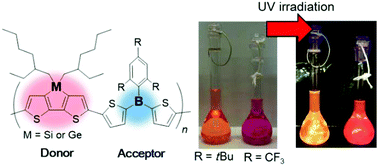Hybrid conjugated polymers with alternating dithienosilole or dithienogermole and tricoordinate boron units†
Abstract
Conjugated polymers composed of tricoordinate boron and π-conjugated units possess extended conjugation with relatively low-lying LUMOs arising from pB–π interactions. However, donor–acceptor (D–A) polymers that feature triorganoboranes alternating with highly electron-rich donors remain scarce. We present here a new class of hybrid D–A polymers that combine electron-rich dithienosiloles or dithienogermoles with highly robust tricoordinate borane acceptors. Polymers of modest to high molecular weight are readily prepared by Pd-catalyzed Stille coupling reaction of bis(halothienyl)boranes and distannyldithienosiloles or -germoles. The polymers are obtained as dark red solids that are stable in air and soluble in common organic solvents. Long wavelength UV-vis absorptions at ca. 500–550 nm indicate effective π-conjugation and pronounced D–A interactions along the backbone. The emission maxima occur at wavelengths longer than 600 nm in solution and experience further shifts to lower energy with increasing solvent polarity, indicative of strong intramolecular charge transfer (ICT) character of the excited state. The powerful acceptor character of the borane comonomer units in the polymer structures is also evident from cyclic voltammetry (CV) analyses that reveal relatively low-lying LUMO levels of the polymers, enhancing the D–A interaction. Density functional theory (DFT) calculations on model oligomers further support these experimental observations.



 Please wait while we load your content...
Please wait while we load your content...